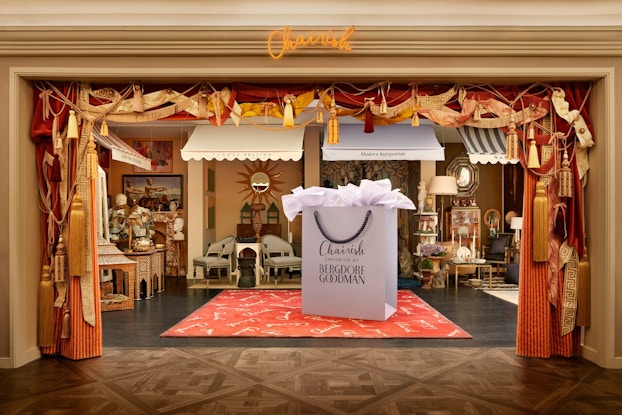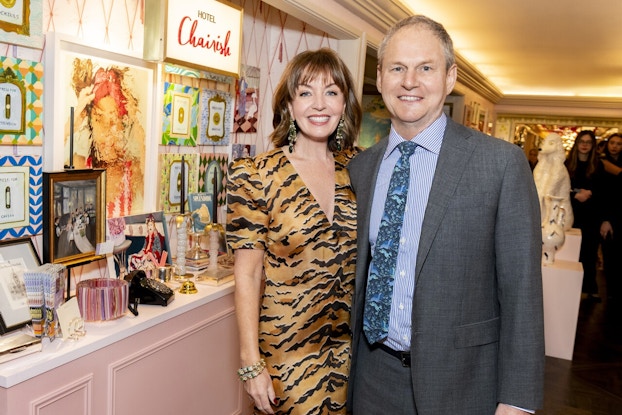
Why it matters:
- The global market for secondhand furniture is expected to double over the next 10 years, to $87.6 billion.
- Since its launch 12 years ago, Chairish has sold more than one million items on its vintage furniture marketplace.
- Tariff concerns and consumer trends are creating strong tailwinds for Chairish and driving growth.
Anna and Gregg Brockway launched online marketplace Chairish in 2013 because they wanted to make it easier to sell and ship pre-owned and vintage pieces of furniture.
Now, 12 years later, they are positioned to take advantage of key tailwinds that are fueling Chairish’s growth. Consumer support for sustainability and resale, concerns about price increases and tariffs, and the growing popularity of vintage furniture pieces are driving gains in sales and customer engagement.
“Tariffs are making vintage even more attractive [to consumers] because it’s stylish pieces with a story to tell, it’s ready to ship now so you don’t have to worry about supply chain challenges or long wait times for getting a piece from a manufacturer, and the value has always been good and it’s getting better. And buying vintage is kinder to the planet,” Gregg Brockway told CO—.
Chairish also enables hundreds of furniture consignment shops and small businesses to connect with customers around the world.
Chairish doesn’t own or warehouse the furniture it sells. Instead, it shows potential buyers a curated list of items and has the tech platform that allows it to quickly calculate shipping costs and connect sellers with the right shipping option.
Growing amid the booming business of secondhand goods
The global market for secondhand furniture is expected to double over the next decade, from $40.2 billion in 2024 to $87.6 billion in 2034, according to market research firm Market.US.
The growth comes as the overall market for secondhand products is booming. Sales of all secondhand products are expected to grow at a compound annual rate of 17.2% annually and exceed $1 trillion by 2025, according to a report by Transparency Market Research.

Four moves in three years inspired the launch of Chairish
Before launching Chairish, Gregg Brockway cofounded two successful travel planning startups, Tripit and Hotwire, and Anna Brockway had worked in fashion as Vice President of Worldwide Marketing for Levi Strauss & Co.
“My wife and I moved four times in three years, and we always had furniture that didn’t fit into the new place and we always were looking for pieces that did fit,” Brockway said. They preferred to find vintage pieces, or furniture with, as Brockway likes to describe it, “a story to tell.”
“One night over a drink or two of wine, commiserating about how hard it was, Anna said, ‘You’re a startup guy, you should solve this problem,’” Brockway said.
He responded that she was the creative thinker who should solve the problem. They decided to tackle the challenge together and Chairish was born.
“We’re trying to help the secondary market for home furnishings become more liquid,” Brockway said. “Most people don’t know how to ship a piece of furniture across town, let alone across country or around the world, and that’s made it a really hard secondary market to bring to life,” he said.
The listings on Chairish aren’t thrift store finds, but luxury and upscale pieces with years of life in them and enough value to merit shipping across country or overseas.
For the past three years, Chairish has displayed its offerings in a pop-up emporium at New York’s luxury department store landmark, Bergdorf Goodman.
Initially, Chairish focused exclusively on furniture, but it has since expanded to include artwork, home décor, and jewelry, along with some curated new merchandise.
[Read more: Resale’s Next Big Wave: Execs From ThredUp to Trove on How Tech and Brand Adoption Are Driving Secondhand Retail Boom]
Brockway sees a broader shift toward vintage furniture and pieces with 'a story to tell.'
A network of small businesses source Chairish’s marketplace inventory of curated, upscale finds
The Brockways originally envisioned Chairish as a strictly peer-to-peer marketplace, with individuals selling to other individuals. But they quickly realized that there were a lot of small businesses looking to resell furniture—either consignment stores or individuals who make a living finding sought-after furniture pieces to resell.
“We call them professional sellers,” Brockway said. “Today most of our listings come from professional sellers.”
Having a large number of listings from professional sellers helps Chairish provide a more curated and vetted selection of furniture. For items such as jewelry and artwork, the company typically works only with professional sellers and galleries, to avoid issues like fraud and counterfeiting.
For individual, nonprofessional sellers who wish to list on Chairish, the company has a team of curators who can help assess the value and advise the seller about their listing.
Solving Chairish’s price discovery and shipping cost transparency challenges
Two of the tech challenges Chairish faced when it launched were finding a way to quickly show buyers the cost to ship a purchase and creating a format that allows for price discovery.
Chairish has relationships with shippers around the country and around the world. It also has a preferential relationship with UPS for items shipping within the United States.
“The buyer wants to know, before they run their credit card, what it’s going to cost to get that beautiful piece to where they want it to go,” Brockway said. “We created a way of estimating, before the transaction happens, exactly how much it’s going to cost you to get it in your home.”
Price discovery is another issue that makes it harder to resell furniture, he said. “People don’t have a good sense of what furniture is worth, so we let people list it and then we let people make offers.”
“If you list a piece for $1,500, and I think it’s only worth $900, then I can make you an offer for $900 and maybe you’ll accept it, or maybe it will be a price in the middle, and there’s a little back and forth, which is what happens in consignment stores” and other markets, Brockway said.
Chairish makes money by taking a commission on sales, and also by providing additional paid services for sellers, including advertising and expedited payment options.
As inflation, high interest rates, and a sharp drop in home sales created headwinds for the home furnishing and décor industry in recent years, Chairish set a goal of becoming consistently profitable. It has been EBITDA (earnings before interest, taxes, depreciation, amortization) profitable for the most recent consecutive four quarters.
That Chairish could show profitability during one of the slowest periods for home sales in recent history makes Brockway confident that the company is poised for even stronger growth.
[Read more: 3 Consumer Brand Founders and CEOs on Finding Growth in B2B Channels]

Sales to interior designers up 14% due to tariff concerns
Interior decorators and designers are a big part of Chairish’s customer base, and the company has seen 14% year-over-year growth in its to-the-trade business.
Brockway believes that is largely due to the impact increased tariffs are expected to have on prices and shipping delays.
“Interior designers are our savviest customers. They are often the leading indicator —the first mover—on trends,” he said. Since the tariff announcement this spring, the portion of Chairish’s sales going to interior designers has grown twice as fast as previously, he said.
The company also has seen a 700% increase in engagement and sell-through in response to ads and marketing messages featuring Chairish’s “tariff-free” merchandise.
While tariffs could affect sales into the United States from overseas sellers on Chairish, 85% of the listings on the site are items that are already in the United States and free from any tariff impact.
A broader trend toward sustainability and vintage expected to drive sales
Beyond tariffs, Brockway sees a broader shift toward vintage furniture and pieces with “a story to tell.”
“It’s definitely a growing trend,” he said. “When we launched Chairish initially we saw it as a big opportunity, but it wasn’t seen as a cool opportunity by design lovers.”
Now, he said, “it’s becoming increasingly common for buyers of all sorts to think of buying something vintage as a kinder, planet-friendly thing to do.”
CO— aims to bring you inspiration from leading respected experts. However, before making any business decision, you should consult a professional who can advise you based on your individual situation.
CO—is committed to helping you start, run and grow your small business. Learn more about the benefits of small business membership in the U.S. Chamber of Commerce, here.

Interested in a small business membership?
Find out how the U.S. Chamber of Commerce can help your company grow and thrive in today's rapidly-evolving business environment. Connect with our team to learn how a small business membership can benefit your bottom line and help you achieve your goals.







